Design and Implementation of Charge Pump Phase-Locked Loop Frequency Source Based on GaAs pHEMT Process
Abstract
:1. Introduction
2. Design of CPPLL
2.1. Phase Frequency Detector (PFD)
2.2. Charge Pump (CP)
2.3. Voltage-Controlled Oscillator (VCO)
2.4. Frequency Divider (FD)
3. Measurement Result and Discussion
4. Conclusions
Author Contributions
Funding
Institutional Review Board Statement
Informed Consent Statement
Data Availability Statement
Conflicts of Interest
References
- Drago, S.; Leenaerts, D.M.W.; Nauta, B.; Sebastiano, F.; Makinwa, K.A.A.; Breems, L.J. A 200 µA Duty-Cycled PLL for Wireless Sensor Nodes in 65 nm CMOS. IEEE J. Solid-State Circuits 2010, 45, 1305–1315. [Google Scholar] [CrossRef] [Green Version]
- Kim, B.-H.; Hong, Y.; An, Y.-J.; Kim, S.-G.; Lee, H.-J.; Kim, S.-W.; Hong, S.-B.; Yun, G.-H.; Yook, J.-G. A Proximity Coupling RF Sensor for Wrist Pulse Detection Based on Injection-Locked PLL. IEEE Trans. Microw. Theory Tech. 2016, 64, 1667–1676. [Google Scholar] [CrossRef]
- Pimenta, M.; Gurleyuk, C.; Walsh, P.; O’Keeffe, D.; Babaie, M.; Makinwa, K.A.A. A 200-μW Interface for High-Resolution Eddy-Current Displacement Sensors. IEEE J. Solid-State Circuits 2021, 56, 1036–1045. [Google Scholar] [CrossRef]
- Avila, H.E.D.L.; de Andrade, G.A.; de Sousa, F.R.; Pagano, D.J. Modeling and Analysis of a PLL-Based Resonant Frequency Tracking System Using a Resonant Cavity Sensor. IEEE Sens. J. 2019, 19, 7447–7459. [Google Scholar] [CrossRef]
- Ghafari, B.; Koushaeian, L.; Goodarzy, F. An ultra low power and small size PLL for wearable and implantable medical sensors. In Proceedings of the 2012 IEEE Consumer Communications and Networking Conference (CCNC), Las Vegas, NV, USA, 14–17 January 2012; pp. 409–412. [Google Scholar] [CrossRef]
- Chen, Z.; Lin, M.; Zheng, Y.; Wei, Z.; Huang, S.; Zou, S. Single-Event Transient Characterization of a Radiation-Tolerant Charge-Pump Phase-Locked Loop Fabricated in 130 nm PD-SOI Technology. IEEE Trans. Nucl. Sci. 2016, 63, 2402–2408. [Google Scholar] [CrossRef]
- Kim, K.-S.; Kim, K.; Yoo, C. A fREF/5 Bandwidth Type-II Charge-Pump Phase-Locked Loop with Dual-Edge Phase Comparison and Sampling Loop Filter. IEEE Microw. Wirel. Compon. Lett. 2018, 28, 825–827. [Google Scholar] [CrossRef]
- Hou, N.; Li, Z. Design of high performance CMOS charge pump for phase-locked loops synthesizer. In Proceedings of the 2009 15th Asia-Pacific Conference on Communications, Shanghai, China, 8–10 October 2009; pp. 209–212. [Google Scholar] [CrossRef]
- Tang, L.; Wang, Z.; Qiu, Y.; Zhang, C.; Xu, J. An ultra-high speed monolithic clock recovery circuit in 0.2-µm GaAs process. Analog. Integr. Circuits Signal Process. 2015, 83, 45–53. [Google Scholar] [CrossRef]
- Messinger, T.; Muller, D.; Antes, J.; Wagner, S.; Tessmann, A.; Kallfass, I. Divide-by-8 phase detector MMIC for PLL-based carrier recovery in E-band communication. In Proceedings of the 2015 German Microwave Conference, Nuremberg, Germany, 16–18 March 2015; pp. 237–240. [Google Scholar] [CrossRef]
- Moon, J.-W.; Choi, K.-C.; Choi, W.-Y. A 0.4-V, 90~350-MHz PLL With an Active Loop-Filter Charge Pump. IEEE Trans. Circuits Syst. II Express Briefs 2014, 61, 319–323. [Google Scholar] [CrossRef]
- Lee, D.-G.; Nikoofard, A.; Mercier, P.P. A −254.1-dB FoM 2.4-GHz Subsampling PLL With a −76-dBc Reference Spur by Employing a Varactor-Based Cancellation Technique. IEEE Solid-State Circuits Lett. 2020, 3, 102–105. [Google Scholar] [CrossRef]
- Levantino, S.; Marzin, G.; Samori, C.; Lacaita, A.L. A Wideband Fractional-N PLL With Suppressed Charge-Pump Noise and Automatic Loop Filter Calibration. IEEE J. Solid-State Circuits 2013, 48, 2419–2429. [Google Scholar] [CrossRef]
- Cathelin, A. Fully Depleted Silicon on Insulator Devices CMOS: The 28-nm Node Is the Perfect Technology for Analog, RF, mmW, and Mixed-Signal System-on-Chip Integration. IEEE Solid-State Circuits Mag. 2017, 9, 18–26. [Google Scholar] [CrossRef]
- Lee, H.; Lee, W.; Kim, T.; Helaoui, M.; Ghannouchi, F.M.; Yang, Y. 6–18 GHz GaAs pHEMT Broadband Power Amplifier Based on Dual-Frequency Selective Impedance Matching Technique. IEEE Access 2019, 7, 66275–66280. [Google Scholar] [CrossRef]
- Zhang, C.; Wang, H.; Zhang, J.; Du, G. Experiment and Simulation of the Nonlinear and Transient Responses of GaAs PHEMT Injected With Microwave Pulses. IEEE Trans. Electromagn. Compat. 2015, 57, 1–7. [Google Scholar] [CrossRef]
- Huang, F.-H.; Lin, C.-K.; Wu, Y.-S.; Chan, Y.-J.; Wang, Y.-C. A $W$-band Injection-Locked Frequency Divider Using GaAs pHEMTs and Cascode Circuit Topology. IEEE Microw. Wirel. Compon. Lett. 2007, 17, 885–887. [Google Scholar] [CrossRef]
- Yang, Z.; Chen, Y.; Yang, S.; Mak, P.-I.; Martins, R.P. A 10.6-mW 26.4-GHz Dual-Loop Type-II Phase-Locked Loop Using Dynamic Frequency Detector and Phase Detector. IEEE Access 2019, 8, 2222–2232. [Google Scholar] [CrossRef]
- Liu, L.; Gao, S.; Mu, J.; Zhu, Z. A Low Power and Low Current-Mismatch Charge Pump with Dynamic Current Compensation. J. Circuits Syst. Comput. 2018, 28, 1920007. [Google Scholar] [CrossRef]
- Sohrabi, A.A.; Ehsanian, M. A widebound low phase noise LC-VCO based PLL with automatic amplitude control. In Proceedings of the 2014 26th International Conference on Microelectronics (ICM), Doha, Qatar, 15–18 December 2014; pp. 44–47. [Google Scholar] [CrossRef]
- Ting, Y.; Yuming, Z.; Hongliang, L.; Yimen, Z.; Yue, W.; Yifeng, L. Design and Implementation of a low-phase-noise GaAs HBT VCO. J. Semicond. 2018, 45, 30–34. [Google Scholar]
- Hajimiri, A.; Lee, T. Design issues in CMOS differential LC oscillators. IEEE J. Solid-State Circuits 1999, 34, 717–724. [Google Scholar] [CrossRef] [Green Version]
- Kim, B.; Ko, J.-S.; Lee, K. A new linearization technique for MOSFET RF amplifier using multiple gated transistors. IEEE Microw. Guid. Wave Lett. 2000, 10, 371–373. [Google Scholar] [CrossRef]

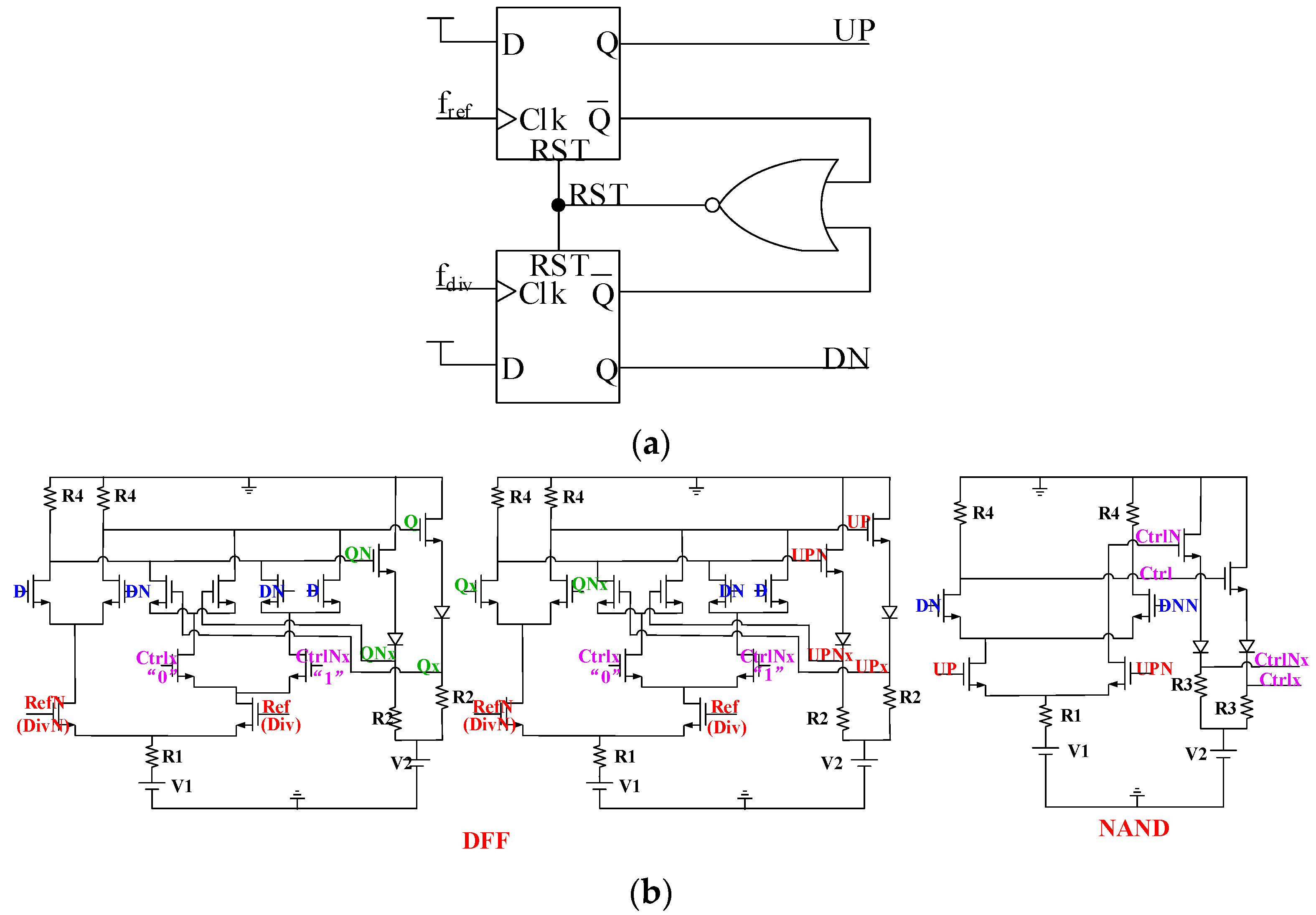
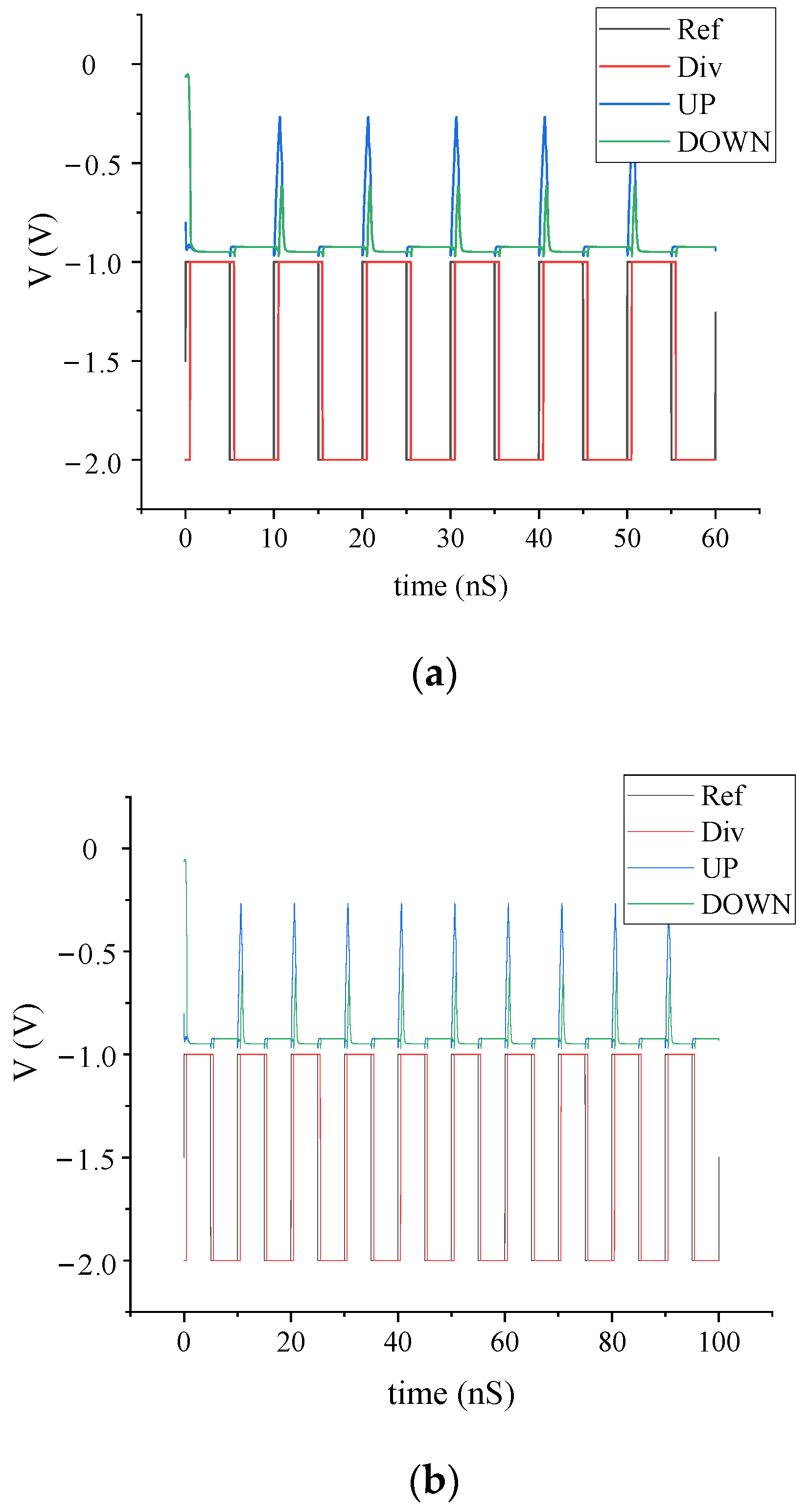
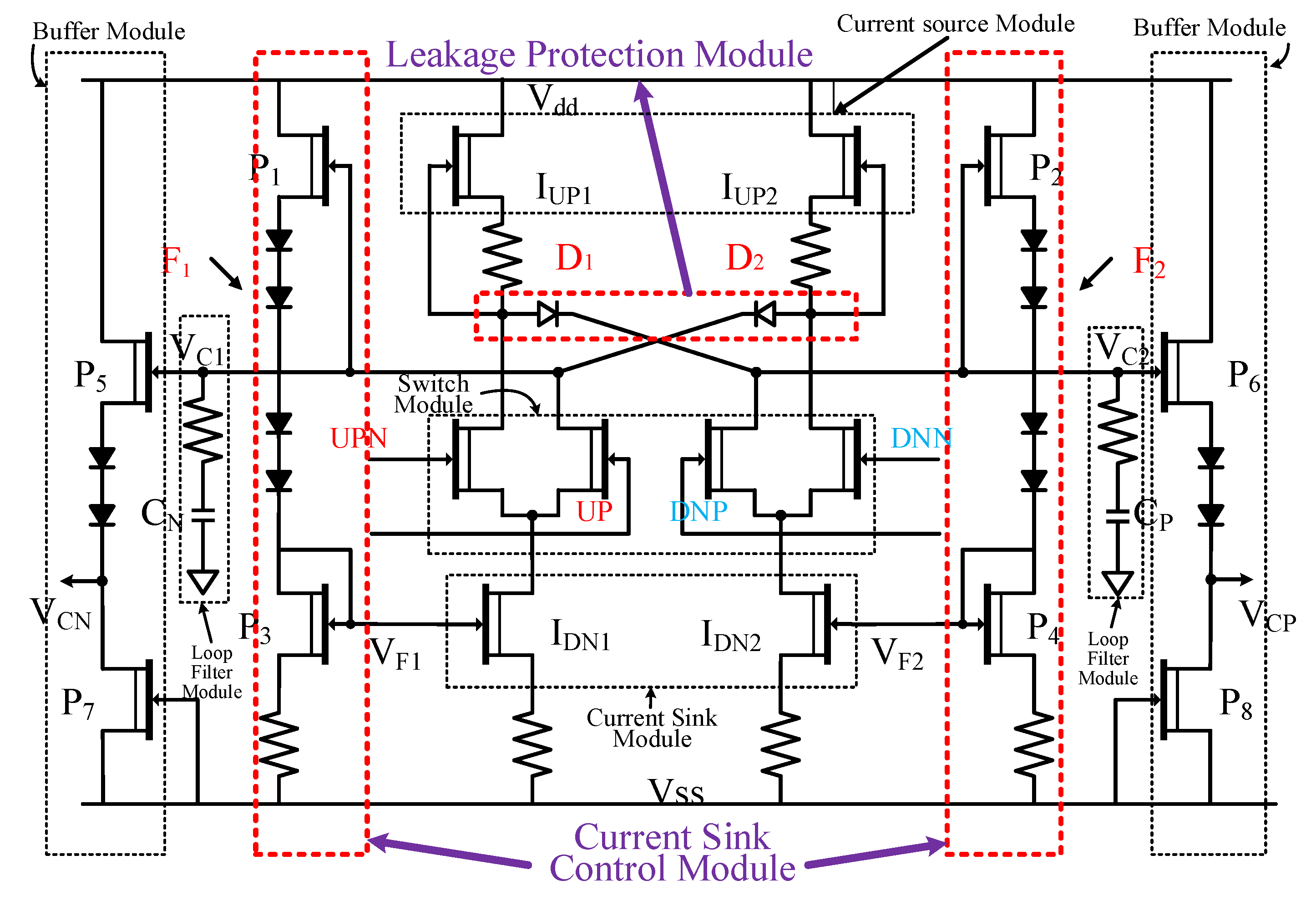
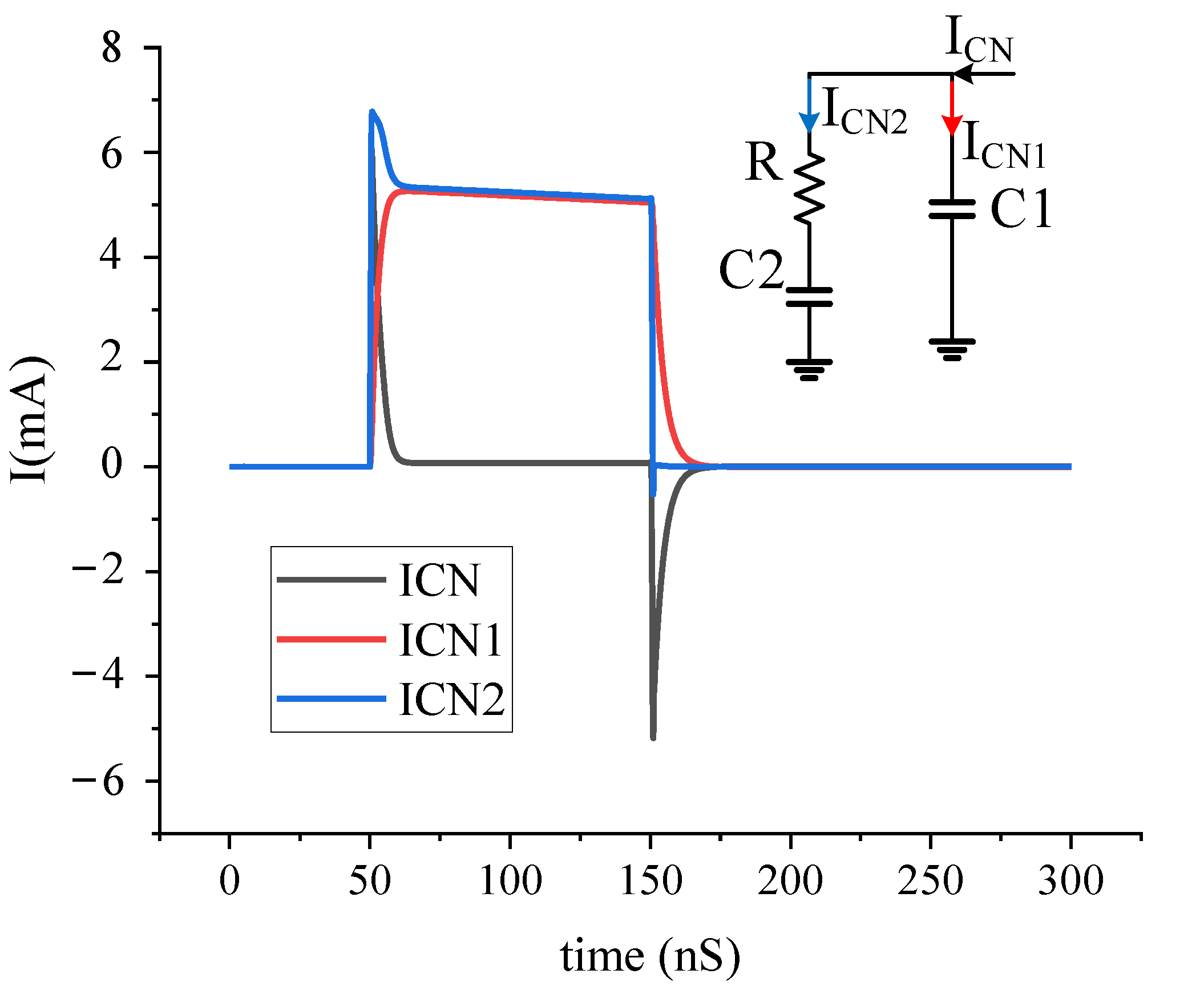
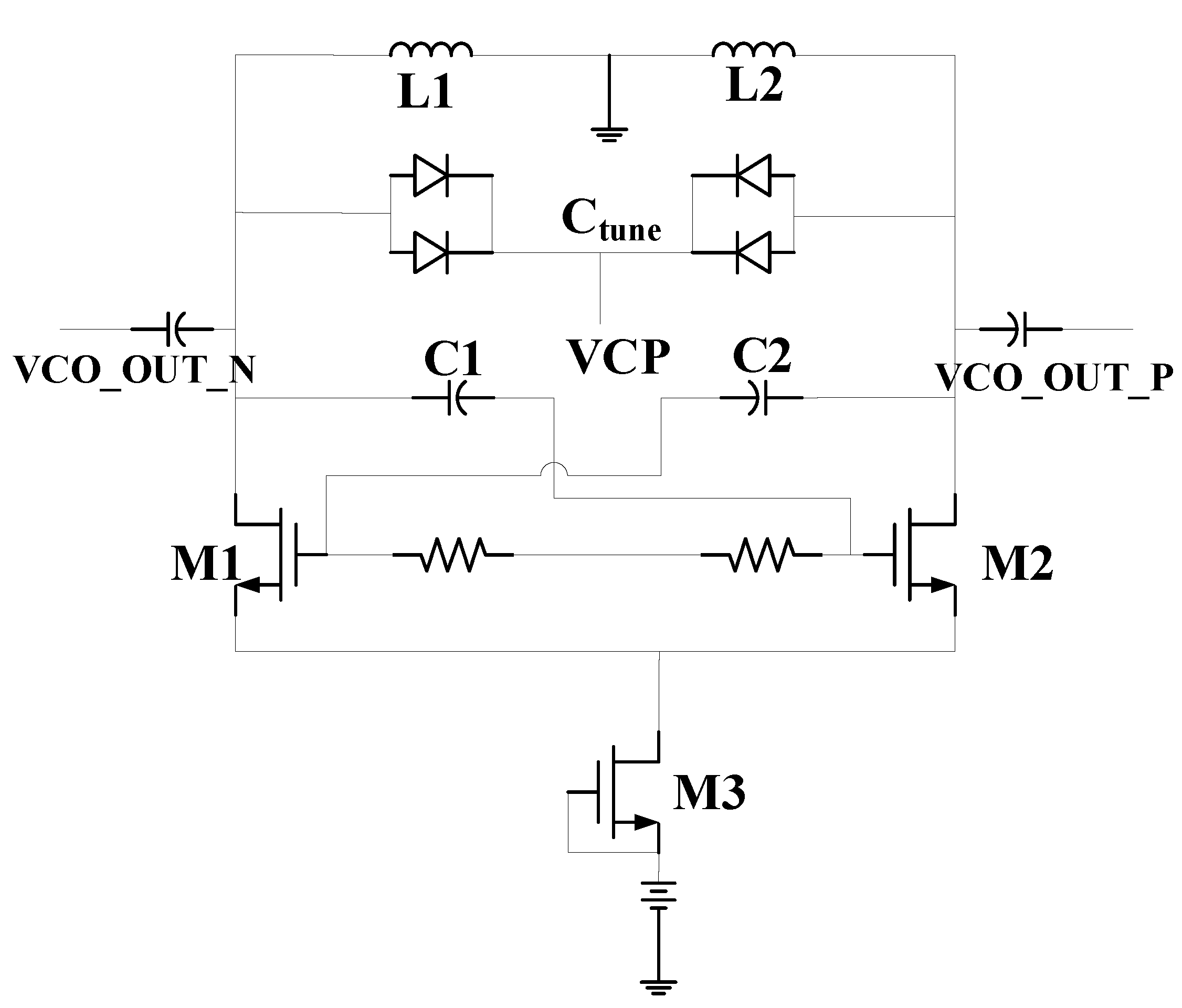
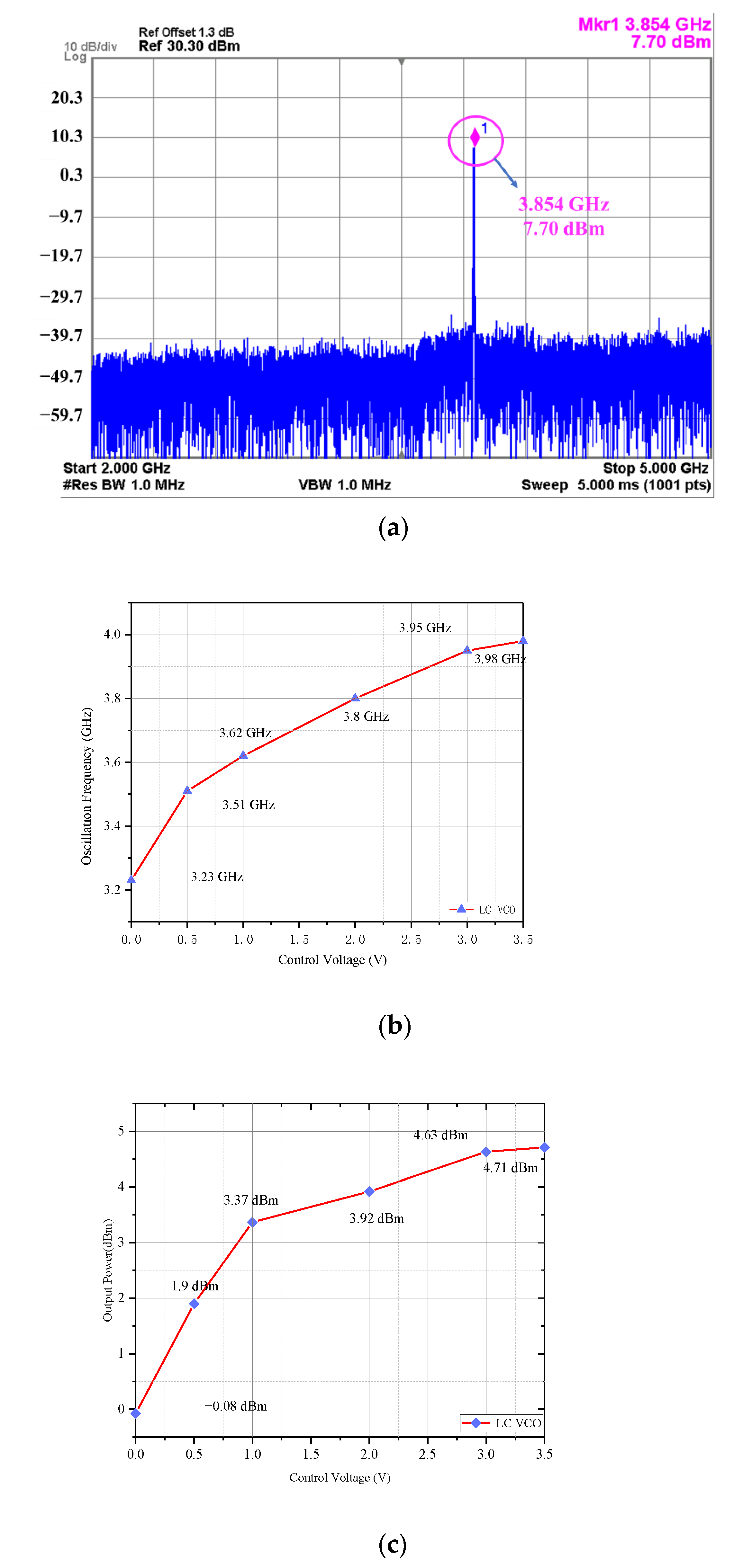

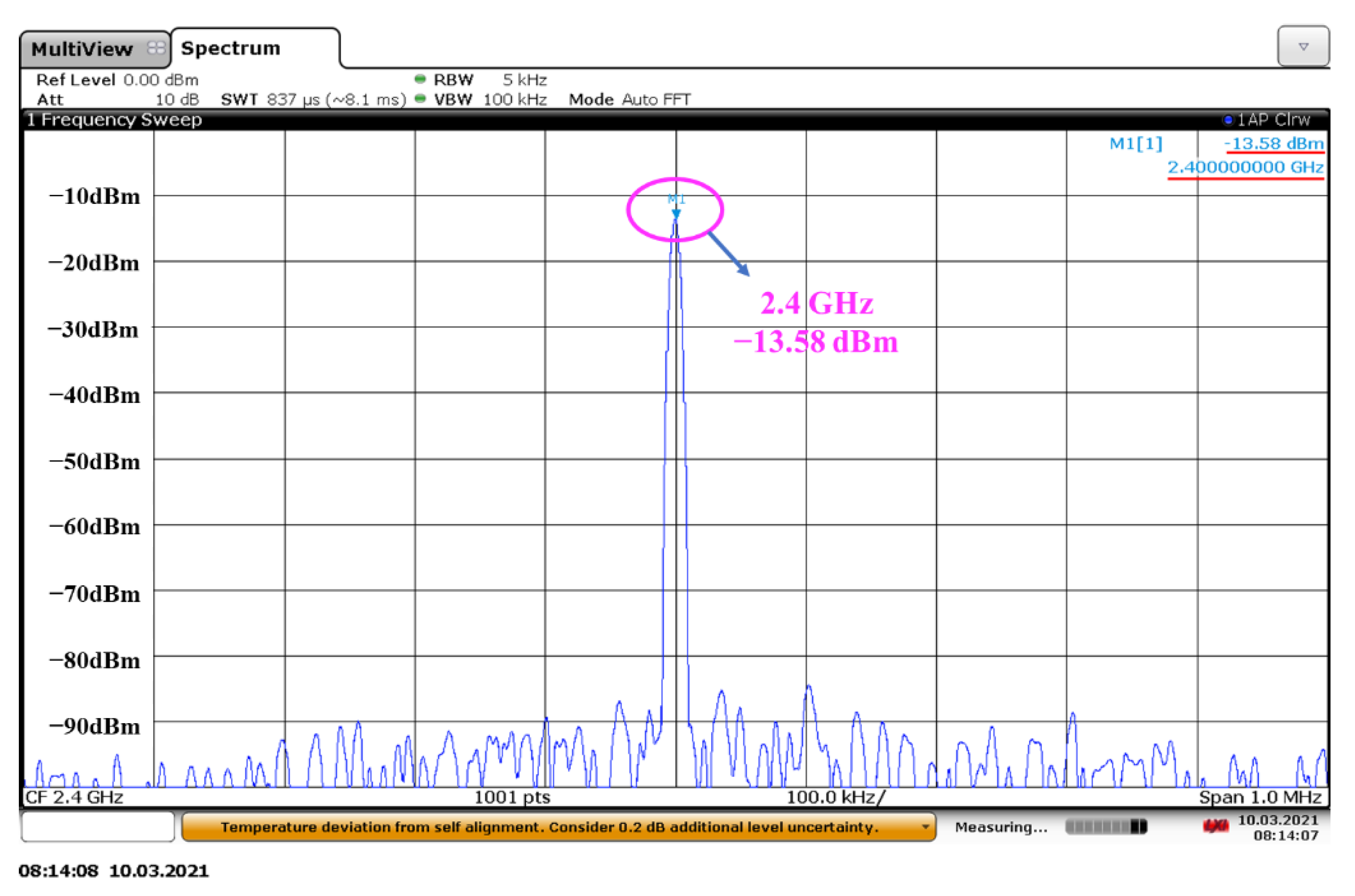

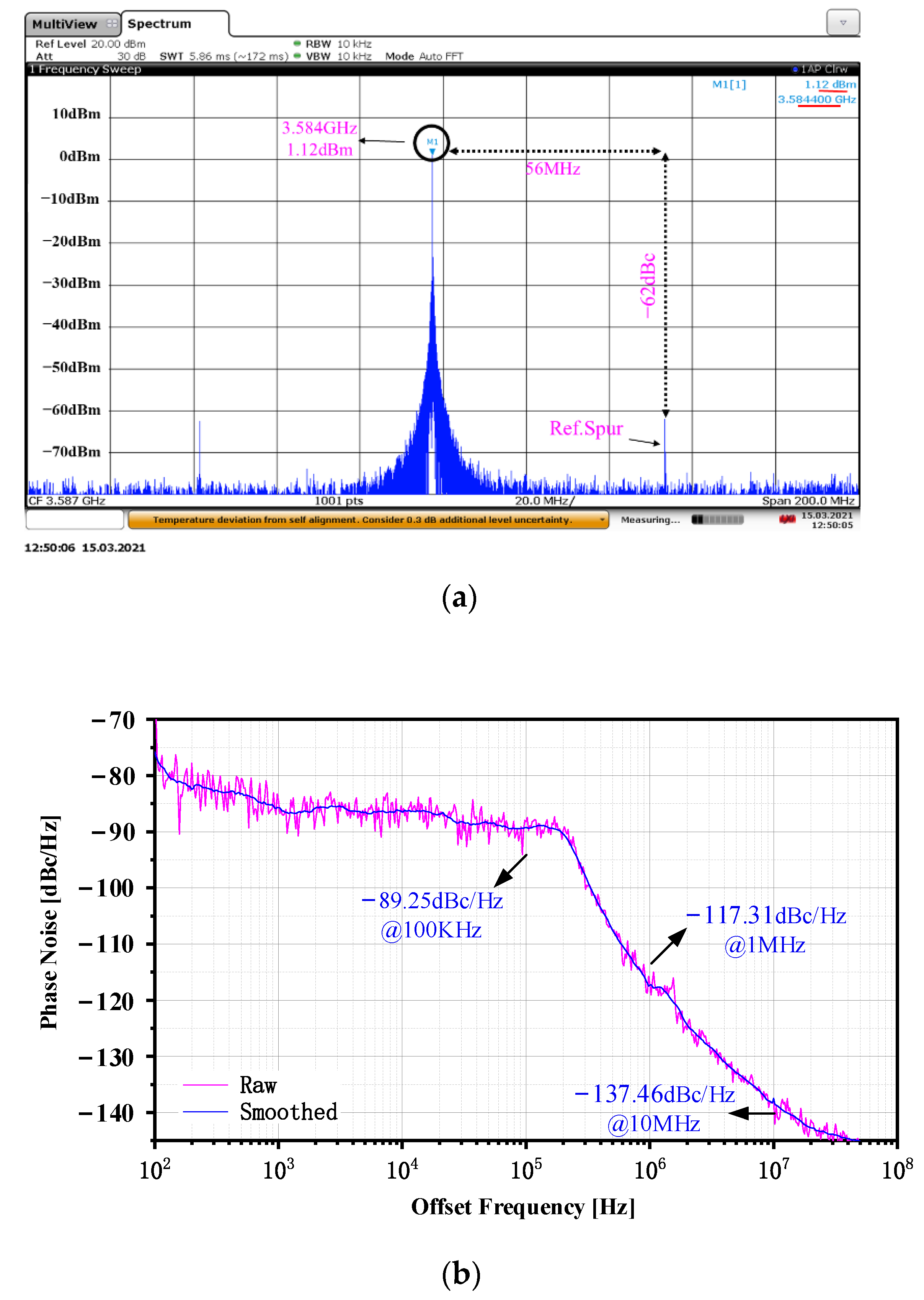

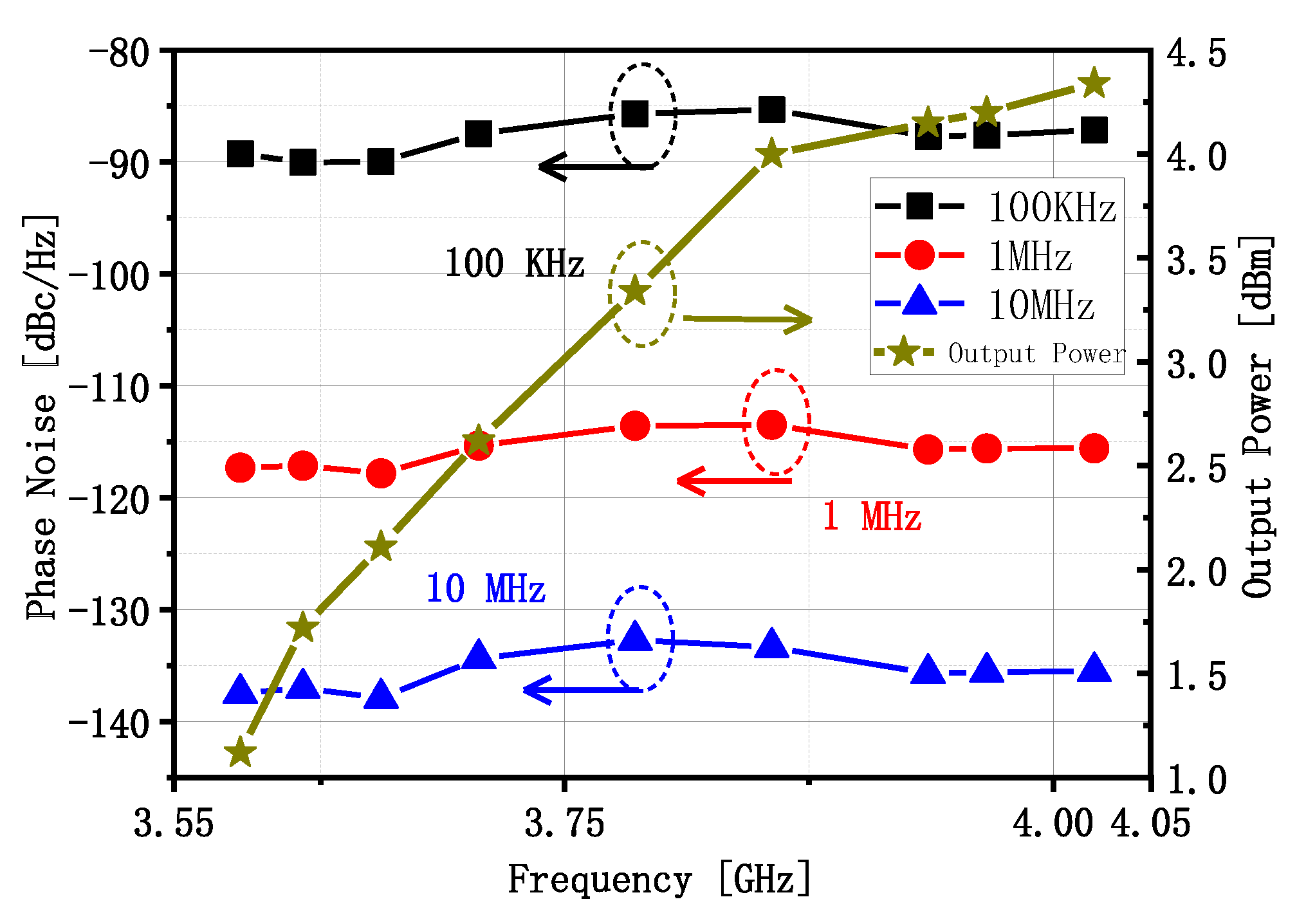
| Ref. | Tech. | Structure | Freq. Range (GHz) | Phase Noise (dBc/Hz) | POUT (dBm) | PDC (mW) | Area (mm2) |
|---|---|---|---|---|---|---|---|
| [11] | 65 nm Si CMOS | CPPLL | 0.09–0.35 | −90@1MHz | −8 | 0.109 | 0.0081 |
| [12] | 65 nm Si CMOS | CPPLL | 2.4 | −122@1MHz | −2.25 | 1.02 | 0.3 |
| [9] | 0.2 μm GaAs pHEMT | APLL | 37 | −98@1MHz | - | 480 | 1.7 |
| This Work | 0.15 μm GaAs pHEMT | CPPLL | 3.584–4.021 | −117.8@1MHz | 4.34 | 39.69 | 2.7 × 3.4 |
Publisher’s Note: MDPI stays neutral with regard to jurisdictional claims in published maps and institutional affiliations. |
© 2022 by the authors. Licensee MDPI, Basel, Switzerland. This article is an open access article distributed under the terms and conditions of the Creative Commons Attribution (CC BY) license (https://creativecommons.org/licenses/by/4.0/).
Share and Cite
Zhao, R.; Zhang, Y.; Lv, H.; Wu, Y. Design and Implementation of Charge Pump Phase-Locked Loop Frequency Source Based on GaAs pHEMT Process. Sensors 2022, 22, 504. https://doi.org/10.3390/s22020504
Zhao R, Zhang Y, Lv H, Wu Y. Design and Implementation of Charge Pump Phase-Locked Loop Frequency Source Based on GaAs pHEMT Process. Sensors. 2022; 22(2):504. https://doi.org/10.3390/s22020504
Chicago/Turabian StyleZhao, Ranran, Yuming Zhang, Hongliang Lv, and Yue Wu. 2022. "Design and Implementation of Charge Pump Phase-Locked Loop Frequency Source Based on GaAs pHEMT Process" Sensors 22, no. 2: 504. https://doi.org/10.3390/s22020504
APA StyleZhao, R., Zhang, Y., Lv, H., & Wu, Y. (2022). Design and Implementation of Charge Pump Phase-Locked Loop Frequency Source Based on GaAs pHEMT Process. Sensors, 22(2), 504. https://doi.org/10.3390/s22020504





